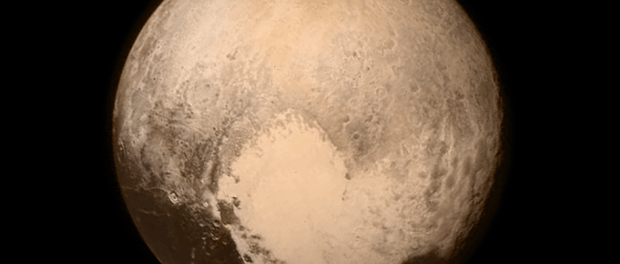Book of the Month Club: Astronomy 101 by Carolyn Petersen
 NASA's latest voyage of discovery, a mission to Pluto named New Horizons, helped the world see Pluto up close for the first time in photographs such as these. Photo credit: NASA.
NASA's latest voyage of discovery, a mission to Pluto named New Horizons, helped the world see Pluto up close for the first time in photographs such as these. Photo credit: NASA.
“Pluto is still the same world it was before the announcement. The change in status from planet to dwarf planet didn’t affect its physical parameters one bit. But it does allow better classification of the worlds of the outer solar system, and that’s important.”
With the recent photographs of Pluto by NASA’s spacecraft, New Horizons, you might want to know more about the universe in which we live. Petersen’s book, while simple, is a great way to start learning about the little and big things in our universe, and possibly become interested, too.
Divided by topic, the chapters are short and digestible in small parts. This is the kind of book where you don’t have to keep track of all the plotlines (are there any, after all?) and can easily pick back up and skip to another chapter without having missed anything else. The book contains some interesting facts: the moon can have “moonquakes” and one of Jupiter’s moons, Ganymede, is larger than the planet Mercury, to name two.
This book picked up after a discussion of the planets, when it got into a discussion of comets and meteors, stars, and famous names astronomy history, which were the things I was really looking for in the book. Dispersed within these chapters are amazing little photographs taken by the NASA telescopes that are easily found (and downloaded full size for your viewing pleasure) on Wikimedia Commons. From naming meteors to a vision of what the Sun may look like when it reaches its final point in its life, the facts given by this book are fascinating. I found the biographies of important people in astronomy interesting, in particular that of Kepler and the man who discovered Pluto, Clyde Tombaugh.
Though while I was going into this, I expected a more technical book, Astronomy 101 is as it should be: easy, simply written, an introduction. Things do get more technical, however, as the book nears its end with discussions about gamma-ray astronomy and other concepts, but it is still written in simple English. Anybody can understand it. I imagine it would be able to be a good introduction for a child or for an adult who is interested in learning a bit more about the universe we live in. And yes, aliens are discussed.
Read more about NASA’s mission to Pluto here.





